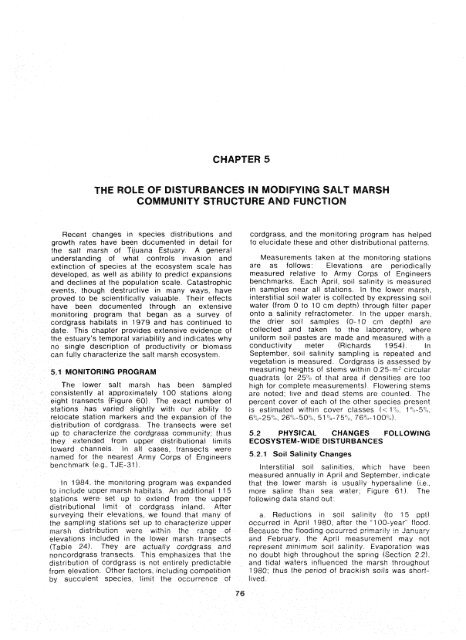The Ecology of Tijuana Estuary, California: An Estuarine Profile
The Ecology of Tijuana Estuary, California: An Estuarine Profile
The Ecology of Tijuana Estuary, California: An Estuarine Profile
Create successful ePaper yourself
Turn your PDF publications into a flip-book with our unique Google optimized e-Paper software.
CHAPTER 5<br />
THE ROLE OF DISTURBANCES IN MODIFYING SALT MARSH<br />
COMMUNITY STRUCTURE AND FUNCTION<br />
Recent changes In specles d~strrbutions and<br />
growth rates have been documented In detail for<br />
the salt marsh <strong>of</strong> <strong>Tijuana</strong> <strong>Estuary</strong> A general<br />
understanding <strong>of</strong> what controls rnvasron and<br />
exlinctron <strong>of</strong> species at the ecosystem scale has<br />
developed, as well as abrlrty to predrct expanstons<br />
and declrnes at the population scale Catastrophrc<br />
events, though destructive in many ways, have<br />
proved to be scrent~frcally valuable <strong>The</strong>lr effects<br />
have been documented through an exterls~ve<br />
monltor~ng program that began as a survey <strong>of</strong><br />
cordgrass habrtats in 1979 and has continued to<br />
date This chapter provides extensive ev~dence <strong>of</strong><br />
the estuafy's temporal variabil~ty and lndrcates why<br />
no slnglc descrrption <strong>of</strong> productivcty or bromass<br />
can fully characterize the salt rnarsh ecosystnm<br />
cordgrass, and the monitoring program has helped<br />
to elucidate these and other distributional patterns.<br />
Mcasurements taken at the monitoring statlons<br />
are as follows Elevatrons are periodically<br />
measured relatrve to Army Corps <strong>of</strong> Engineers<br />
benchmarks Each Aprll, soil salinity IS measured<br />
In samples near all statrons In the iower marsh,<br />
~nterst~tial soil water IS collected by expressing so11<br />
water (from 0 to 10 crn depth) through frlter paper<br />
onto a salinity refractometer In the upper marsh,<br />
the dr~er soil samples (0-10 crn depth) are<br />
collected and taken to the laboratory, where<br />
unrform so11 pastes are made and measured wrth a<br />
conductrvtty meter (Rrchards 1954) In<br />
September, soil salinrty sampling is repeated and<br />
veqetation IS measured Cordqrass IS assessed bv<br />
0 25-m7 ctrcula;<br />
quadrats (or 25"a <strong>of</strong> that area if densities are too<br />
5.1 MONITORING PROGRAM m&asurlng helghts <strong>of</strong> stems wih~n<br />
<strong>The</strong> lower salt rnarsh has been sampled high for complete measurements) Flowering stems<br />
consistently at apgrOxlmately 100 stations along are noted, live and dead stems are counted <strong>The</strong><br />
eight transects (Frgure 601 <strong>The</strong> exact number <strong>of</strong> percent cover <strong>of</strong> each <strong>of</strong> the other species present<br />
stat~ons has varied sirgb)tly wrth our abrlrtv to 1s estrrnated w,thin cover classes (i I",. lo0-5%,,<br />
relocaie station markers and the expansion <strong>of</strong> the 6",-25",,, 26"~~-50~,,, 51 ?,-75"0. 76uu-1 OOL",)<br />
distributiorl <strong>of</strong> corclarass <strong>The</strong> transects were set<br />
up to characterize fhe cordgrass cornmunrty, thus 5.2 PHYSICAL CHANGES FOLLOWING<br />
they extended from upper drstributionai limits ECOSYSTEM-WIDE DISTURBANCES<br />
toward channeis In ail cases. trarisects were<br />
5.2.1 Soif Salinity Changes<br />
named tor the nearest Army Corps <strong>of</strong> Erlg~neers<br />
beilchmark (e g . TJE-31)<br />
In 1984, the monitoring program was expanded<br />
to rnclude upper marsh habltals <strong>An</strong> additional 115<br />
stattons were set up lo extend from the upper<br />
dfstrrbutlonal llmlt <strong>of</strong> cordgrass inland. After<br />
surveying their elevations, we found that many <strong>of</strong><br />
the sampling StatlOnS set up to characterrre upper<br />
rrlarsh dtstrtbution were within the :ange oi<br />
eievatlcrns included rn the lower marsh transects<br />
(Table 241 <strong>The</strong>y are actually cordgrass and<br />
noncordgrass transects This emphasrzes that the<br />
distrrbutlon <strong>of</strong> cordgrass IS not entrrely predtctahie<br />
from eievation Other factors, rnclud~ng competrt~an<br />
by succulent species, ltrnrt the occurrence <strong>of</strong><br />
Interstitial soil salinrties, which have been<br />
measured annually In April and September, Indicate<br />
that the lower marsh is usually hypersaline (I e,<br />
more saline than sea water, Figure 61) <strong>The</strong><br />
followrng data stand out<br />
a Reductrons in soil salintty (to 15 ppt)<br />
occurred in April 1980, after the "100-year" flood<br />
Because !he f!ood:ng occ3rrcd pr:msrtiy tc Jaituarp<br />
and February, the April measurement may not<br />
represent mrnimum sot! salrniiy Evaporatron was<br />
no doubt hrgh throughout the spring (Sectton 2 21,<br />
arrd t~dal waters influenced the marsh throughout<br />
f 980, thus the perrod <strong>of</strong> brackish so~ls was shortlived

















